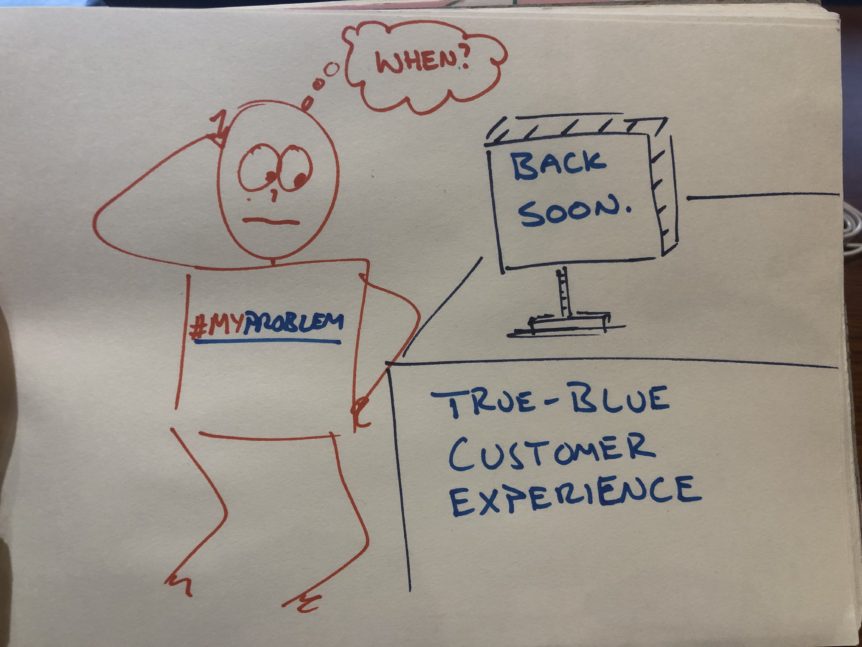I had a fantastic chat a few weeks ago with author and Theory of Constraints consultant Gordon Dunbar. We were comparing notes on recent trends here in Australia. One of the topics that came up was this strategy of elevation to the supersystem, where, in an effort to cut costs, companies push more and more responsibility for service support onto the customer.
Unfortunately, the lack of customer service in Australia is truly remarkable. There is a lack of care, a lack of follow through, and a lack of genuine interest in the customer’s well-being. It is nearly the worst I’ve seen around the world. Much like our broadband fiasco.
It is industry agnostic, and it is so pervasive and widespread that it’s become part of the Australian culture. It’s something that most Australians recognise and yet laugh off because it seems so ingrained in our Service DNA.
And what’s most disconcerting about this situation is the lip service that organisations pay to customer centricity in their advertising and marketing campaigns while having literally zero evidence to back it up. Tracking NPS doesn’t make you a customer-led organisation. Neither does establishing and reporting Key Success Factors for customer experience in your strategy.
Think about it:
Your internet goes down. Does anyone call you to say this?:
“Hello, our systems just detected a drop in your service. No action is required on your part. We’ll have your connection restored within 2 hours and send you a notification once it’s up and running. Oh, and because of this inconvenience, we are going to apply a $10 credit to your account.”
The reality of customer experience in Australia is very much like this:
The internet goes down—That’s my problem.
I have to ring my service provider—That’s my problem.
They’ll send someone out but I have to work from home—That’s my problem.
The tech never showed up—That’s my problem.
The tech had the wrong address—That’s my problem.
There were no notes against my complaint—That’s my problem.
I didn’t receive a credit for the outage—That’s my problem.
Meanwhile, you pay your bill every month, on time, as part of your contract. You pay whether the speeds are good, bad, or non-existent. But any issues, any questions, any support you need—that’s all your problem.
Broadband is a low-hanging fruit. Clearly. But the repositioning of any and all product- or service-related issues squarely onto the customer is the epidemic we’re facing, and it’s primarily a strategy to reduce fixed costs within the organisation. The more effort and touchpoints that an organisation can shift away from their internal workforce and onto the customer, the more cost they can cut.
This topic opened up a discussion between Dunbar and I about purpose. It seems like one of the major contributors to this Australian customer-service-failure phenomenon is lack of understanding of purpose and the importance of satisfying necessary conditions to achieve that purpose.
Purpose matters:
- It matters in every decision to undertake a strategic imperative.
- It matters in determining which key success factors will underpin those strategies.
- It matters in every single project initiative undertaken to support those strategies.
- It matters in designing and establishing the leading and lagging scorecard metrics that will be used to track those initiatives.
- And it matters in your customer experience strategy.
Purpose matters.
Dunbar made a really excellent point during that conversation: if your organisation is a for-profit business, then frankly, it has only one purpose: to make money. Making money is the purpose that defines the organisation’s reason for existence. The founders or investors who established that organisation did so to make money.
Managers of most Australian companies lose the plot through their lack of understanding of purpose and which necessary conditions are required to achieve that purpose. Necessary conditions are simply the requirements that must be satisfied in order to attain the purpose. Therefore, the absence of even a single necessary condition means the purpose is unattainable.
Enter effortless customer experience, stage right.
For many organisations, one of those necessary conditions may be to ensure the customer experience associated with their product or service is as effortless and pain-free as possible. Cutting cost, however, at the expense of customer experience, may not be a necessary condition.
The point is, if designing a customer experience environment where the customer puts forth zero effort and achieves instant satisfaction is a necessary condition to maximising your organisation’s profitability, then you had better stop paying it lip service and start designing with the customer in mind.
Until next time—

Mike is the Founder and General Manager of Redshift Consulting, Founder of Praetorian Code, and Board Member to the International Business TRIZ Association. He holds a Masters in Innovation and Entrepreneurship (UMD) and a Bachelors in Psychology and Education (UCSB). He is a Certified Lean Six Sigma Black Belt (UTS); Certified Practitioner of Theory of Inventive Problem Solving (TRIZ); former US Army Ranger and a Brazilian Jiu-Jitsu fanatic.

